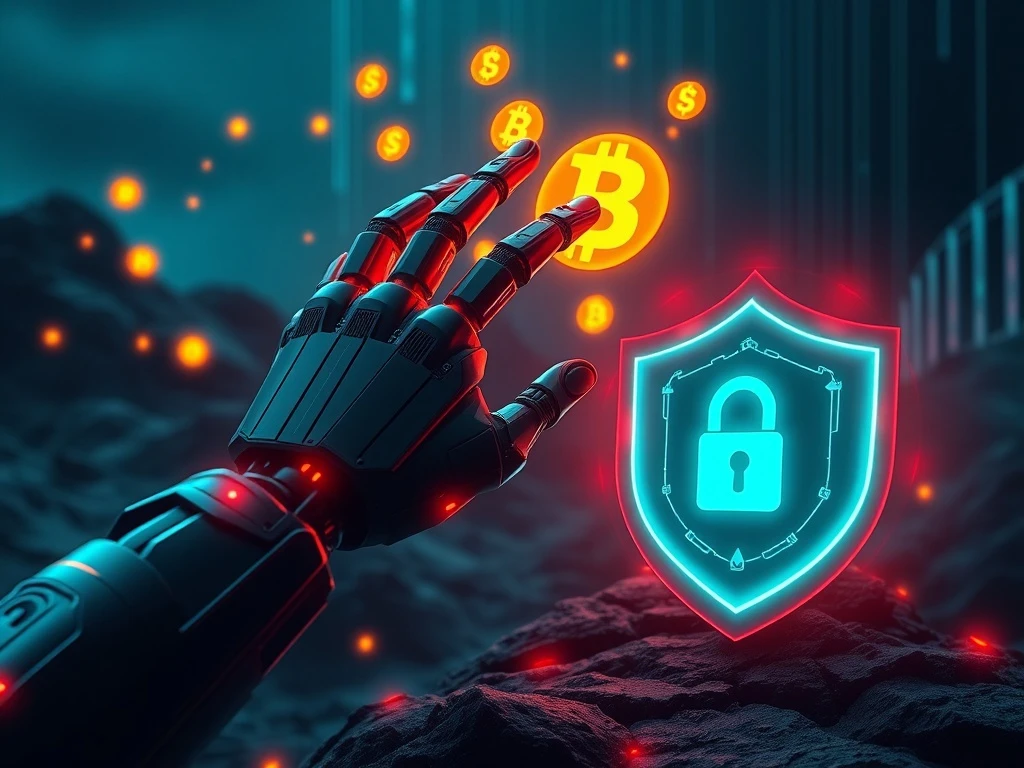Unmasking the AI Crypto Threat: Vigilant Strategies for Digital Asset Security

The cryptocurrency industry, once celebrated for its groundbreaking decentralized innovation, now faces an escalating challenge: the **AI crypto threat**. This isn’t just a technical or regulatory hurdle; it’s a psychological battle, leveraging human trust and the rapid pace of technological evolution to exploit vulnerabilities. As major platforms like Coinbase, Binance, and Kraken grapple with the fallout, understanding these threats is crucial for investors assessing the long-term viability of crypto’s prominent players.
Unmasking the Evolving AI Crypto Threat Landscape
Artificial intelligence has revolutionized fraud, transforming basic phishing attempts into hyper-personalized, multi-layered attacks. The **AI crypto threat** manifests in several insidious forms:
- Deepfake Impersonations: AI-generated videos and audio mimicking CEOs, regulators, or influencers are now central to “pig butchering” schemes. Victims are groomed over months, building trust before being lured into fake trading platforms that drain their funds.
- AI-Generated Phishing: Sophisticated AI tools create nearly identical replicas of legitimate service interfaces, such as MetaMask. Users unknowingly surrender their private keys, losing access to their digital assets.
- Automated Social Engineering: State-sponsored groups, like North Korea’s Lazarus Group, weaponize AI to automate social engineering campaigns. These target both unsuspecting retail users and compliance professionals within crypto firms, seeking to infiltrate systems or gain sensitive information.
The collapse of the CBEX trading platform in April 2025 serves as a stark example of the scale of this **AI crypto threat**. By fabricating transaction data and tokenomics using AI, the platform defrauded millions before disappearing. Similarly, rug-pull scams in Argentina and the memecoin frenzy of 2024–25 were amplified by AI tools that streamlined the creation of fraudulent tokens. These incidents are not isolated; they represent systemic vulnerabilities exploiting the very speed and accessibility that initially made crypto appealing.
Strengthening Crypto Security: Lessons from Recent Breaches
How are major players responding to these sophisticated attacks, and what can we learn about bolstering **crypto security**?
Coinbase’s $400 Million Lesson
In May 2025, Coinbase experienced a high-profile breach rooted in social engineering. Hackers bribed overseas customer support agents to exfiltrate sensitive user data, including government IDs and transaction histories. While no funds were directly stolen, the incident triggered subsequent phishing campaigns that cost victims millions. The financial impact on Coinbase is estimated at $180 million to $400 million, covering reimbursements, legal fees, and system upgrades. This event highlighted a critical weakness in **crypto security**: centralized custody and third-party risk.
Regulatory scrutiny followed, with the SEC launching an investigation into Coinbase’s 2021 IPO, questioning the accuracy of its user metrics. The company’s stock price dropped significantly, reflecting investor anxiety. Coinbase’s refusal to pay a $20 million ransom and its establishment of a $20 million reward fund were strategic moves to restore trust and demonstrate commitment to **crypto security**.
Binance and Kraken: Proactive Measures in Crypto Security
Binance and Kraken, though also targeted by similar AI-driven attacks, demonstrated stronger resilience due to proactive **crypto security** measures:
- Binance: Deployed AI-driven monitoring systems to detect bribery attempts in real-time. These systems flagged suspicious language patterns in customer service interactions, preventing potential data exfiltration.
- Kraken: Enforced strict access controls under the “least-privilege” principle. This limits support agents to only the data necessary for their specific roles, significantly reducing the surface area for attack.
These strategies underscore the importance of integrating human-centric security protocols with advanced AI defenses in an era where AI amplifies both offensive and defensive capabilities. Their proactive stance showcases how robust **crypto security** can mitigate the impact of sophisticated threats.
Assessing the Financial Risks to Crypto Platforms
The breaches and scams have tangible consequences, particularly concerning **financial risks** for platforms and investors alike. The direct costs of breaches, such as reimbursements and legal fees, are substantial. For Coinbase, the estimated $180 million to $400 million in damages from its May 2025 incident illustrates the direct **financial risks** involved. Beyond immediate costs, there are indirect financial impacts:
- Regulatory Fines: Investigations by bodies like the SEC can result in hefty fines, adding to the financial burden.
- Lost Revenue: Eroding investor trust can lead to reduced trading volumes and user exodus, directly impacting a platform’s profitability.
- Increased Operational Costs: Investing in advanced security systems, training, and compliance measures becomes a continuous, significant expense.
These **financial risks** are not just theoretical; they directly affect stock performance and market capitalization, making security a paramount concern for investors.
Navigating Reputational Risks in a Digital Age
Beyond the financial toll, these incidents inflict severe **reputational risks**, which are arguably even more damaging in the long run. Investor trust is a fragile asset, especially in an industry still grappling with regulatory ambiguity. The impact on Coinbase’s stock price, which fell after the SEC investigation into its user metrics was disclosed, vividly illustrates the immediate effect of **reputational risks**.
Coinbase’s subsequent pivot to reporting “monthly transacting users” instead of “verified users” signals a move towards greater transparency, but it also reveals the inherent fragility of trust. In contrast, Kraken, despite its own past SEC charges, has managed to maintain a stronger security reputation. Its Wyoming Special Purpose Depository Institution (SPDI) charter, a first for a crypto-native bank, positions it as a bridge between traditional finance and digital assets. The platform’s 95% cold storage rate and military-grade encryption have bolstered confidence, helping it navigate regulatory hurdles and mitigate **reputational risks** effectively.
Binance, while not directly implicated in recent high-profile breaches, remains a wildcard. Its global dominance in trading volumes is undeniable, but its persistent regulatory challenges, particularly in the U.S., could strain investor trust. While its AI-driven defenses might mitigate some operational risks, its opaque governance structure continues to be a source of potential **reputational risks**.
Why Decentralization is Our Strongest Defense
The proliferation of AI scams has significantly accelerated the shift towards decentralized infrastructure. This growing emphasis on **decentralization** is not merely a philosophical stance; it’s a practical response to mitigating centralized vulnerabilities. Here’s why **decentralization** is becoming increasingly vital:
- Reduced Single Points of Failure: By removing human intermediaries and centralized control points, decentralized protocols inherently reduce the targets for social engineering and large-scale data breaches.
- User Control Over Private Keys: Non-custodial wallets and DeFi protocols empower users to retain full control over their private keys. This means that even if a platform is compromised, user funds remain secure, as they are not held by a third party.
- Transparency and Immutability: Decentralized ledgers offer unparalleled transparency and immutability, making it far more difficult for fraudulent data or fabricated transactions to go unnoticed, unlike the CBEX platform.
While usability challenges remain for broader adoption, the long-term trend suggests that platforms prioritizing **decentralization** will increasingly attract security-conscious investors looking to minimize their exposure to centralized risks.
The Path Forward: Security Innovation, Regulatory Alignment, and True Decentralization
For investors navigating this complex landscape, success hinges on focusing on three critical pillars:
- Security as a Competitive Advantage: Platforms that invest heavily in AI-powered behavioral detection tools, suchable blockchain analytics solutions like Elliptic, will likely outperform their peers. Coinbase’s post-breach upgrades, including enhanced agent monitoring and a $400 million user protection fund, are steps in the right direction. However, the ultimate goal should be decentralized alternatives that remove human intermediaries.
- Regulatory Resilience: The SEC’s scrutiny of user metrics and compliance practices will only intensify. Platforms that proactively align with emerging regulations, such as Kraken’s SPDI charter, will gain a first-mover advantage. Conversely, those that resist oversight, like Binance in certain jurisdictions, risk prolonged legal battles and severe reputational damage.
- Embracing Decentralization as a Hedge: The rise of AI scams has accelerated the shift toward decentralized infrastructure. DeFi protocols and non-custodial wallets, where users control private keys, inherently reduce exposure to centralized vulnerabilities. While usability remains a hurdle, the long-term trend favors platforms and solutions that champion decentralization.
Investment Advice: Balancing Risk and Opportunity
The crypto landscape in 2025 demands a nuanced investment approach. Short-term risks are pronounced, with regulatory actions, reputational hits, and AI-driven fraud capable of destabilizing even established platforms. However, long-term opportunities lie in companies that demonstrate adaptability and resilience.
- Coinbase (COIN): A high-risk, high-reward bet. Its recent stock volatility reflects ongoing challenges, but its market resilience, evidenced by its S&P 500 inclusion, suggests potential for recovery. Investors should closely monitor the SEC’s IPO investigation and the company’s progress in rebuilding trust.
- Kraken (KRAKEN): A more defensive play. Its regulatory innovation and strong security track record position it as a leader in the transition to crypto-native banking. However, ongoing SEC enforcement actions could delay its growth trajectory.
- Binance: A speculative bet. Its global dominance and AI-driven defenses are significant strengths, but its U.S. regulatory challenges remain a major wildcard. Investors should watch for clear signs of comprehensive compliance overhauls.
Conclusion: A Test of Adaptability in the Digital Frontier
The AI-powered crypto scams of 2025 are more than just a technological crisis; they are a profound test of the industry’s ability to adapt and evolve. For platforms like Coinbase, the path forward demands more than just stronger firewalls; it requires a fundamental reimagining of trust in a digital age. For investors, the lesson is clear: the winners in this new era will be those who prioritize robust **crypto security**, embrace regulatory clarity, and recognize that **decentralization** is not merely a buzzword but an absolute necessity for long-term viability. As the industry continues its rapid evolution, one truth remains paramount: in crypto, as in all finance, trust is the most valuable currency of all.
Frequently Asked Questions (FAQs)
Q1: What is the primary AI crypto threat facing the cryptocurrency industry?
The primary **AI crypto threat** involves sophisticated AI-powered scams like deepfake impersonations, AI-generated phishing sites, and automated social engineering campaigns. These attacks are highly personalized and aim to deceive users into surrendering private keys or investing in fraudulent platforms, leading to significant financial losses and reputational damage.
Q2: How can individuals enhance their personal crypto security against AI scams?
To enhance personal **crypto security**, individuals should use hardware wallets for cold storage, enable multi-factor authentication (MFA) on all accounts, be extremely skeptical of unsolicited communications (even from seemingly legitimate sources), verify URLs carefully, and educate themselves on common scam tactics like “pig butchering” schemes.
Q3: What are the main financial risks associated with AI-powered crypto scams for platforms?
For crypto platforms, the main **financial risks** include direct costs from reimbursing victims, significant legal fees from regulatory investigations and lawsuits, potential fines from governing bodies like the SEC, and a loss of revenue due to eroded investor trust leading to reduced trading volumes and user attrition. These can amount to hundreds of millions of dollars.
Q4: How do reputational risks impact crypto companies, and how can they be mitigated?
**Reputational risks** can severely erode investor trust, leading to stock price drops, decreased user engagement, and a tarnished brand image. Companies can mitigate these risks by prioritizing transparent communication during and after breaches, investing heavily in advanced security measures, demonstrating proactive regulatory compliance (like Kraken’s SPDI charter), and fostering a culture of security and accountability.
Q5: Why is decentralization considered a key solution to the AI crypto threat?
**Decentralization** is crucial because it removes single points of failure inherent in centralized systems. By empowering users with control over their private keys via non-custodial wallets and DeFi protocols, it reduces reliance on third-party security. This architecture makes it significantly harder for AI-powered social engineering or data breaches to compromise user funds on a large scale, thereby enhancing overall system resilience.










